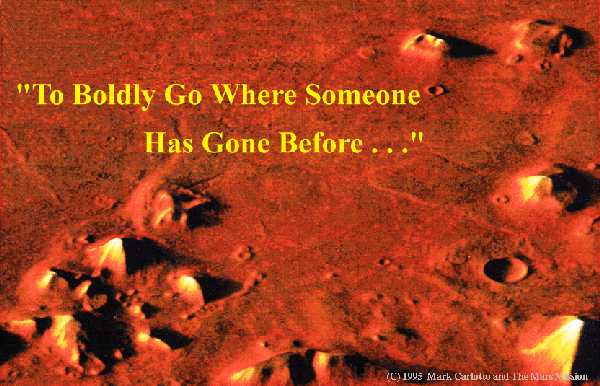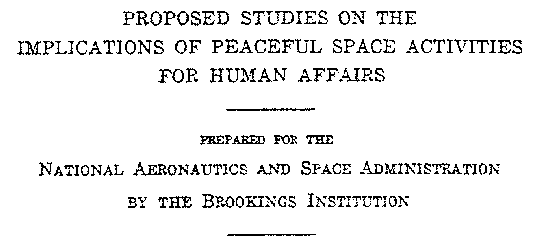



spirit of what NASA used to be... than does
the current NASA..."
-- Alan Keyes, Republican Candidate for
President, Dallas Primary Debate,Spring, 1996
Public understanding of major achievements of the Space Age over the past 30 years -- carried out by both the former Soviet Union and the United States -- increasingly seems to have been nothing more than a carefully constructed "version" of a much more extraordinary truth.
Even Apollo 11 astronaut Neil Armstrong, in a recent White House ceremony, hinted at the existence of such information, when he cryptically ended his prepared remarks by saying, "...we have only completed a beginning; we leave you much that is undone... there are... breakthroughs available to those who can remove one of truths protective layers. There are places to go beyond belief..."
Space imaging data, made available to the Mars Mission (13-year independent space research group) investigation of these possibilities, from a variety of official sources (including increasing "inside leaks"), now strongly suggests the presence (on at least two worlds -- Mars and the Moon) of extensive ancient artificial structures in the solar system. The most celebrated of these potential "ancient artificial structures" is known to millions as the "Face on Mars" -- a mile long, 1500-foot high Martian landform that eerily resembles a humanoid face, lying in a Martian desert called "Cydonia"... where no "face" belongs.



Nearby, lie equally provocative structures which resemble vast, formerly enclosed, ancient and now crumbling "high tech pyramids"... possible former "environmental arcologies" left by
someone who tried to make Mars "home"... long before our fleeting, recent visits.
Far more disturbing than this evidence (if it is indeed disturbing, to a generation raised on "Star Trek"...) is other, equally-documented evidence of a profound, deliberately politically-motivated cover-up of this important data by both major spacefaring nations... for more than 30 years.
The recent "re-discovery" of an official government study ("The Brookings Report" as reported in the New York Times, December 15, 1960), predicting NASA's future acquisition of precisely this type of highly controversial solar system data ("[ancient ET] artifacts left at some time... on the Moon, Mars, or Venus..."), coupled with Brookings' strong recommendation to withhold such information from the American people because of fears of "severe social instability," is only one more piece of mounting, contemporary evidence now suggesting the existence of an extra-ordinary, wide-spread, global "official coverup" of this entire subject.



The Enterprise Mission -- and this corresponding Web Site -- thus represent a deliberate transfer of the previous "one planet" Mars Mission "artifact" investigation to a greater venue: an expanding research program seeking the facts behind the discovery in the last 4 years of "intelligently-designed, ancient artificial structures" on additional NASA and Soviet photos, not only of Mars... but of the Moon...
Including -- surface photographs of "artifacts" taken by the American astronauts themselves.
Enterprise thus will be the "flagship" of an expanded solar-system-wide research effort, designed to carry out the widest possible investigation of these photographs, and to discern the truth...
Ultimately, the mission of this "Enterprise" must be to actively involve the public in this broad-based effort... for without your participation, we will never return NASA to its original founding Charter -- a "completely open NASA," as it was initially envisioned in 1958 by a far-seeing Congress and a former "Supreme Allied Commander" -- later, President Eisenhower.
In pursuit of these objectives, "Enterprise" will continue to explore (and present for discussion here) a wide range of "highly controversial concepts" based on the last 13 years of previous investigation: ranging from proposed "terrestrial connections" for this mounting solar system evidence -- already discerned in ancient terrestrial archaeological sites here on Earth -- to the "new physics" apparently communicated by the geometry found strikingly encoded in many of the "artifacts" on Mars and on the Moon. We will also deal, head on, with the mounting political evidence (such as the discovery of "Brookings") of a deliberate, decades-long "suppression of NASA data " on these discoveries, from the Moon and beyond...
In terms of methodology, analytical research to date has focused on the extensive photographic databases of NASA and Soviet lunar and planetary images. Where applicable, this imaging is being analyzed in its original "analog" photographic format (as in the Apollo astronaut lunar orbital and surface Hasselblad photography); other, unmanned planetary data is currently available as digital databases (or analog TV signals) stored on (rapidly deteriorating!) archived magnetic tape. Both sets of data are currently being converted to digital format by the Enterprise Mission, and studied by teams of independent scientists and other specialists in a variety of fields. These investigators are using a variety of currently available desk-top computers and commercial computer imaging, 3-D CAD programs, and specialized enhancement software -- literally unavailable to NASA (or to the Soviets) when the original data was acquired. These dramatic hardware and software technological analytical advances (over what was available in the preceding 30 years) are the major reason, in our opinion, why "Enterprise" is now finding serious, redundant evidence for "artifacts" on NASA data -- that previous NASA studies seem to have missed... confined as they were to essentially "100-year-old darkroom alchemical techniques!"
In terms of history, the "launching" of the Enterprise phase of this 13-year investigation took place on March 21, 1996 -- with the announcement at the Washington D.C.'s National Press Club, by Richard Hoagland and a team of multi-disciplinary engineers and scientists, of a significantly expanded and broadened Mars Mission/Enterprise Mission escalation of the search. The legacy of over a decade of journal-published, replicated, and peer reviewed scientific work on Mars lay behind the two-hour press conference held in Washington D.C., in March, announcing "Enterprise."
Two years earlier, an intensive year-long independent "peer review" -- a thorough academic study of The Mars Mission Cydonia analysis, and that of other "independent Mars researchers" -- was carried out by Professor (now Professor-Emeritus) Stan McDaniel -- epistemologist, historian of science, and former head of the Philosophy Department of Sonoma State University, in Northern California. The document, in addition to being personally delivered to NASA Headquarters at the conclusion of the Study, was commercially published in 1993 (North Atlantic Books: Berkeley) as "The McDaniel Report: On the Failure of Executive, Congressional and Scientific Responsibility in Investigating Possible Evidence of Artificial Structures on the Surface of Mars and in Setting Mission Priorities for NASA's Mars Exploration Program."



Over the year-long (1992-1993) McDaniel "academic scrutiny" of Hoagland's and the others' work, McDaniel's initial views of the "artifact research" dramatically evolved -- from an initial
position (in his own words) "of considerable scepticism," to--
. . . appreciation for what these researchers [have] done, and the underlying integrity of their work... I [find] that the occasional faults in their work [are] far outweighed by the solidity of thedata and their responsiveness to the needs of what is, after all, the first study of its kind in history.
" As my study of the work done by the independent investigators and NASA's response to their research continued, I became aware not only of the relatively high quality of the independent research, but also of glaring mistakes in the arguements used by NASA to reject this research. With each new NASA document I encountered, I became more and more appalled by the impossibly bad quality of the reasoning used. It grew more and more difficult to believe that educated scientists could engage in such faulty reasoning unless they were following some sort of hidden agenda aimed at suppressing the true nature of the data [emphasis added].
"Eventually my original naive view -- that all NASA scientists were sincerely interested in the truth -- was utterly shattered when I discovered the most blatant piece of disinformation I have
ever seen: one written not by an obscure NASA Public Information employee, but by a prestigeous member of the 1976 Viking Lander Imaging Team, Dr. Carl Sagan. Dr. Sagan's contribution to the subject could not be interpreted as mere scientific bungling"
Even as this objective, surprisingly favorable assessment of the highly controversial "independent Mars research," and the equally negative critique of NASA's 20 years of official rejection and denial, was being hand-delivered to NASA Headquarters, in ashington D.C., an inexplicable event took place in late August of 1993: the sudden and baffling "loss" of NASA's entire Mars Observer spacecraft. This astonishing event occurred just before the spacecraft was scheduled to arrive at Mars -- and well before critical confirmation or falsification of the "Cydonia intelligence hypothesis" could be achieved by on-board cameras.
To those following the "twists and turns" of this increasingly peculiar saga -- particularly to Stan McDaniel -- these events, happening so "conveniently" for NASA on the eve of potential testingof the entire "artifact hypothesis," strongly suggested that the paranoid policy recommendations outlined in "Brookings" over 30 years ago -- potential suppression of all evidence relating to "ET artifacts" -- were somehow still in force.
One slight wrinkle in this situation may have surfaced recently -- surprisingly from Carl himself. Surprising -- because of McDaniel's serious questioning of many aspects (in his voluminous
"Report") of Dr. Sagan's motivations -- if not his long-term role -- in the continuing "Cydonia debate."
As McDaniel documents in great detail, Dr. Sagan's long-term, highly vocal criticism of the "Mars intelligence hypothesis" continues, unabated, in his latest book (The Demon-Haunted
World, New York:Random House, 1995); in Chapter 3, for example, complete with an almost word for word recapitulation of the basic arguments, illogic, and even exact phrases (that so incensed McDaniel), Sagan currently writes:
"The Martian Face is compared to 'similar faces... constructed in civilizations on Earth. The faces are looking up at the sky because they are looking up to God.' Or the Face was constructed
by the survivors of an interplanetary war that left the surface of Mars (and the Moon) pockmarked and ravaged. What causes all those craters anyway? Is the Face a remnant of a long-extinct human civilization? Were the builders originally from Earth or Mars? Could the Face have been sculpted by interstellar visitors stopping briefly on Mars? Might they also have come to Earth and initiated life here? Or at least human life? Were they, whoever they were, gods? Much fervent speculation is evoked...
"When, in August 1993, the Mars Observer spacecraft failed within hailing distance of Mars, there were those who accused NASA of faking the mishap so it could study the Face in detail without having to release the images to the public...
"Put aside the improbability that such a revelation would actually lead to 'world panic'... scientists tend to be effervescent and uncontainable. They have an indomitable compulsion to share new data. Only through prior agreement, not ex post facto, do scientists abide military secrecy [emphasis added]. I reject the notion that science by its nature is secretive. Its culture and ethos are, and for very good reason, collective, collaborative, and communicative...
"When we know only a little about the Face, it raises goosebumps. When we know a little more, the mystery quickly shallows.



"Mars has a surface area of almost 150 million square kilometers, about the land area of Earth. The area covered by the Martian 'sphinx' is about one square kilometer. Is it so astonishing that one (comparatively) postage-stamp-sized mesa in 150 million should look artificial -- especially given our penchant, since infancy, for finding faces? When we examine the neighboring jumble of hillocks, mesas, and other complex surface forms, we recognize that the feature is akin to many that do not at all resemble a human face. Why this resemblance? Would the ancient Martian engineers rework only this mesa (well, maybe a few others) and leave all others unimproved by monumental sculpture? Or shall we conclude that other blocky mesas are also sculpted into the form of faces, but weirder faces, unfamiliar to us on Earth?
"...The best picture of the Face shows one side lit by the Sun, the other in deep shadow.
Using the original digital data, we can severely enhance the contrast in the shadows. When we do, we find something rather unfacelike. The Face is at best half a face. Despite our shortness of breath and the beating of our hearts, the Martian sphinx looks natural -- not artificial, not a dead ringer for a human face. It was probably sculpted by slow geological process over millions of years.
"But I might be wrong...
"It's hard to be sure about a world we've seen so little of in extreme close-up. These features merit closer attention with higher resolution. Much more detailed photos of the 'Face' would surely settle issues of symmetry and help resolve the debate between geology and monumental sculpture. Small impact craters found on or near the Face can settle the question of its age. In the case (most unlikely in my view) that the nearby structures were really once a city, that fact should also be obvious on closer examination. Are there broken streets? Crenelations in the "fort"? Ziggurats, towers, columned temples, monumental statuary. Immense frescoes? Or just rocks?
"Even if these claims are extremely improbable -- as I think they are -- they are worth examining...
"Unlike the UFO phenomenon, we have here the opportunity for a definitive experiment. This kind of hypothesis is falsifiable, a property that brings it well into the scientific arena.
"I hope that forthcoming American and Russian missions to Mars, especially orbiters with high-resolution television cameras, will make a special effort -- among hundreds of other scientific questions -- to look much more closely at the pyramids and what some people call the Face and the city"
To which one can only ask in some bewilderment, "Why did it take so long?

